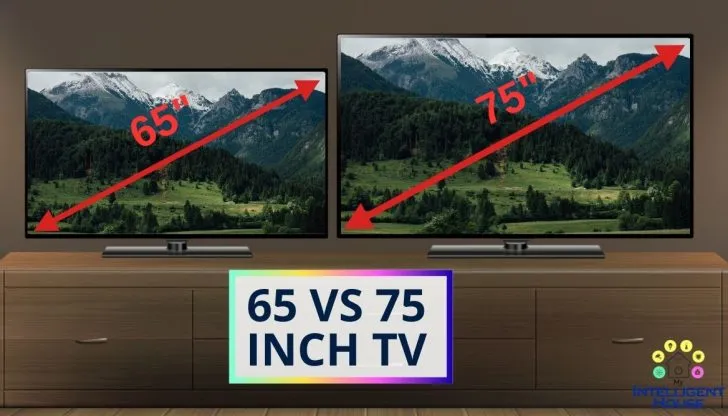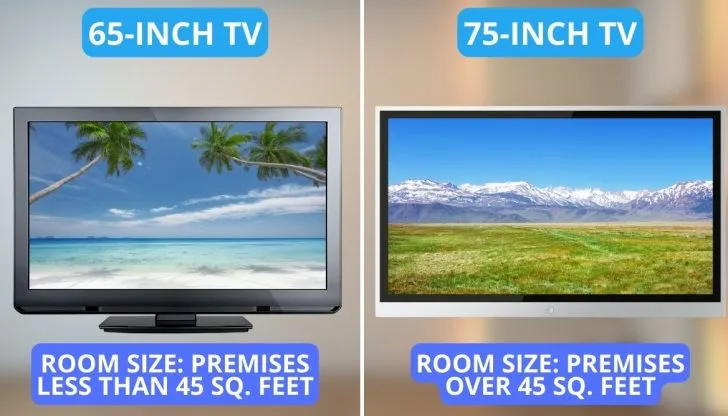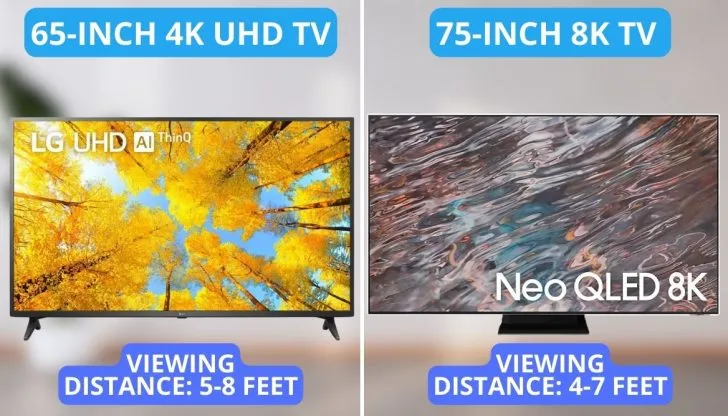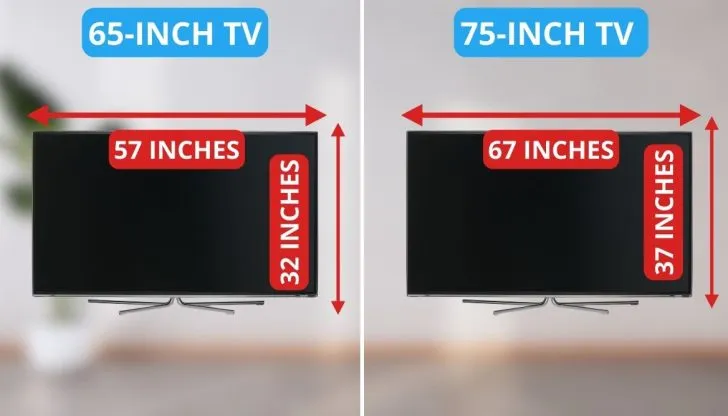Are you trying to figure out which is the best choice between a 65 vs 75-inch TV for your living room? Look no further, I will help you solve this dilemma! I did my research and found 5 major differences between these TVs except dimensions. Let’s not waste a minute and dive into this in-depth comparison guide!

A Quick Comparison
The differences between a 65-inch and a 75-inch TV are many. I’ve listed some crucial differences below to give you a short overview.
- A 75-inch TV has a 15.38% larger diagonal than a 65-inch TV.
- A 65-inch TV is suitable for rooms less than 45 sq ft, while a 75-inch TV is better suited for rooms larger than 45 sq ft area.
- A 75-inch TV can provide a better viewing experience than a 65-inch TV.
- A 75-inch TV costs 200-400 dollars more than a 65-inch TV of the same brand.
But that’s only a small part of what I have in store for you! Keep reading to find out the detailed sizes of 65-inch and 75-inch TVs, which one is preferable to hang on the wall, and which one to mount on a stand. What’s more, I’ll tell you the reasons why TV screen size matters and how the wrong size can lead to eye and neck problems. So, let’s delve into this comparison to decide which one is perfect for your room!
65 vs 75 Inch TV Comparison Chart
Here is an overview chart of 65- and 75-inch TVs. Note that the numbers given are estimated and can vary according to brands and models. Figures after decimal are avoided for easy comparison.
Differencing Factors | 65-inch TV | 75-inch TV |
Average Height | 81 cm | 94 cm |
Average Width | 145 cm | 170 cm |
Average Depth | 5-9 cm | 5-13 cm |
Аverage Area | 11768 cm² | 15994 cm² |
Average Weight | 45-60 lbs | 60-100 lbs |
Minimum Viewing Distance | 6 feet | 7 feet |
Aspect Ratio (16*9) | 13.33% smaller diagonal | 15.38% larger diagonal |
Why Does TV Screen Size Matter? Whole Point
It is a common phenomenon that size matters a lot for immersive viewing. But why? Let me point out.
- Eye Strain: Smaller TV can cause eye strain because your eyes need to focus more on smaller images. On the other hand, big-screen TVs show you a clear picture and your eyes don’t need to concentrate much. But bigger doesn’t always mean better. With the small size of your room and insufficient viewing distance, large TVs can also cause excessive eye strain and lead to vision problems.
- Befitting Look: Your living room should have a suitable and fitting television to create an aura of perfection. A small 65-inch TV won’t look good in an 80-square-foot living room. On the other hand, if the television is 75-inch and the room is as small as 35 square feet, it will look too overwhelming. Therefore, the TV should look better as per your room size.
65″ vs 75″ TV Size: Which One is to Pick?
There are certain things you should consider before you finally push the purchase button. To fit perfectly in your room, your TV size should also be perfect, whether a wall mounting or stand mounting one. Here are some important factors you should note.

1. Ideal Viewing Distance from TV
Distance from television is crucial to watch TV with a cinematic experience. If the distance is too close, your eyes might be affected in the long run. If the distance is too far, you won’t get a better viewing experience, nor good sound quality. Therefore, it is important to consider the viewing distance when choosing the size of the TV.
Here, I’ve given the minimum recommended viewing distance and TV size ratio in a table.
TV size | Distances |
65 inch | 6 feet |
75 inch | 7 feet |
If you are still confused and need details, I welcome you to read my in-depth article: “TV Viewing Distance“.
2. Room Size-TV Size Ratio
Another important factor to consider is the room size, as the suitability of your room depends on the TV to a great extent. You can use the tape measure to measure your room before you pick a TV screen. Now, here are some points you should note.
- Rooms larger than 45 sq ft area should have a 75-inch television.
- Rooms less than 45 sq ft area will need a 65-inch TV.

3. TV Resolution: 4K vs 8K
Most of the movies and content are streamed in 4K resolution today, though 8K resolution provides slightly better-detailed pictures. Larger screens like 75 TVs should have higher resolution for accurate and optimal quality. If you don’t have a problem with the budget, a 75-inch 8K TV should be your first choice. It will provide a better-quality picture than a 65-inch 8K TV.

You should note that the higher the resolution, the closer you can sit to your screen. Higher resolution tends to have little to no effects on the eyes. Look how viewing distance changes over the resolution in the table below.
75-inch TV | 1080 HD | 4K UHD | 8K |
Recommeded viewing distance: | 9-16 feet | 6-9.5 feet | 4-7 feet |
65-inch TV | 1080 HD | 4K UHD | 8K |
Recommeded viewing distance: | 8-14 feet | 5-8 feet | 4-7 feet |
4. TV Placement: Wall Mount vs TV Stand
As the TVs are now becoming lighter, they are easy to wall mount. However, heavy screens are better suited on TV stands. There is no great difference between 65-inch and 75-inch TVs about the placement issue. It’s okay either way for both screen sizes.
- When a 65-inch TV is heavier than 70 pounds it is better not to wall mount.
- When a 75-inch TV is heavier than 100 pounds, it is better to avoid wall mount.
To know the weight of your TV, read my full article: “How Much Does a 65-inch TV Weigh?“.

5. Reasonable Pricing
The prices of 65-inch and 75-inch TVs vary extensively. A 75-inch TV of the same brand can cost you 200-400 bucks more than a 65-inch TV. Here is an estimated price of two popular TV models and their respective pricing for both screen sizes.
Model | 65-inch | 75-inch |
$ 747 | $997 | |
$598 | $798 |
If budget is a notable issue for you, then choosing a 65-inch TV is okay. Otherwise, you should prefer 75-inch TVs.
Understanding the Actual Dimension Differences Between 65 and 75-inch TVs
People simply think and make such a blunder that a 65-inch TV and a 75-inch TV have a difference of 10 inches. Well, the math isn’t that simple. The width and height are outright different, and you should get a good grasp of the difference from the table below.
TV Size | Estimated Height | Estimated Width |
75-inch | 37 inches | 67 inches |
65-inch | 32 inches | 57 inches |
Estimated Difference | 5 inches | 10 inches |
So, when you want to replace or upgrade your Smart TV from 65 to 75 inches, note the differences so that you can properly know the required space for installation or wall mounting.

If you are still confused about the size differences, you should read my articles on 65-inch and 75-inch TV dimensions. Here you go “65-inch TV Dimensions” and “75-inch TV Dimensions“.
Is a 65-inch TV Better Than a 75-inch TV?
A 65-inch new TV is better when:
- When your room size is below 45 square feet.
- You have a limited budget.
And a 75-inch will be better for you when:
- When your room size is more than 45 square feet.
- You have no problem with the budget.
Frequently Asked Questions
Is There a Difference Between Viewing 75 inch TV and 65 inch TV?
Yes, there are differences between viewing 75-inch and 65-inch TV. You can get a better viewing experience from a 75-inch TV than a 65-inch one.
How Much Bigger is a 75-inch TV Compared to a 65-inch TV?
A 75-inch TV has a 33.14% larger area and a 15.38% larger diagonal than a 65-inch TV. Though seemingly the difference isn’t much, in reality, 75-inch TVs are a lot bigger in comparison.
I Plan on Getting an 8k TV, Should I go with the 75-inch or 65-inch?
A 75-inch 8K TV would be slightly better than a 65-inch TV if there’s enough space in the room. So you should go for a 75-inch 8K instead of a 65-inch TV.
Conclusion
Now you know every detail about the 75-inch and 65-inch TVs, and can easily decide which one you should pick. If you are comfortable and the room is spacious enough, 75 inches is your best TV size. This might cost you a few hundred bucks extra, but it will provide an immersive experience.
However, when a 65-inch TV fits your room better and you have a limited budget, your best bet should be on a 65-inch TV. A 65-inch TV is suitable for rooms below 45 square feet area. Note that watching smaller screens from a long distance can cause eye strain.
It is better to wall-mount TVs and you should always sit at least 5-6 feet distant from the display. Always put your TV in direct line with the eyes so that your neck doesn’t hurt. That’s all for today. Have fun!
